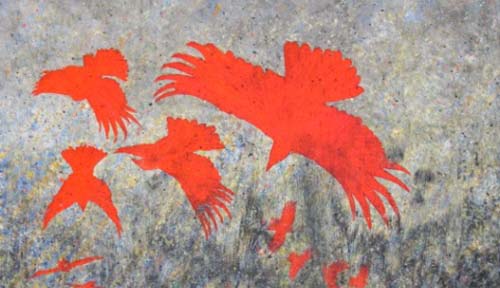
Richard Carter: “Future Beauty” Paintings on Exhibit at David Floria
ASPEN–Richard Carters New Paintings: Future Beauty, constitute a 44-painting series, exploring fire in its contemporary apocalyptic forms””forest fires, prairie fires, fires burning oil in the Gulf of Mexico from the Deep Horizon well, flames of meteor fragments entering the atmosphere. He will show some of them – and an unrelated suite of seven digital prints – at David Floria Gallery in Aspen from September 10 to October 6.
“Even as we dread the catastrophic environmental disasters awaiting us in the future there is to be found a strange majestic beauty in the functioning of nature”¦,” the artist writes in a statement.
Rooted in realism, Carters paintings explore that imagined beauty in thick layers of acrylic on paper or board. He uses intense color contrasts”” brilliant oranges and green blacks, pale yellows and deep blacks, cobalt blues and red oranges, which may or may not have their equivalents in nature. The heavily brushed underpainting of orange or black or white is overlaid with froths of other colors. Flames and trees are brushed or drawn or dripped. Flames paint the sky sometimes crimson, or chartreuse. Embers float in the sky like stars.

Richard Carter
In the process of creating the works Carter sprayed some of the surfaces with water, which gives those areas the softness and translucence of watercolor. There are drips, spatters, nods to the “action painting” that Carter, growing up in Teaneck, New Jersey in the 1950s, said he was aware of going on in nearby Manhattan, or in Pollocks Springs, East Hampton studio. Carters finished work sometimes contains figurative elements, but not always. There are series within the series””the “drip paintings” inspired by images of Russian forest fires, the “red rain” paintings, the “black rain” paintings, the “starry night” paintings.
Future Beauty marks Carters return to painting, and color, after a seven or eight year hiatus, years he spent mostly drawing. His wife Claudette had died; the last of his black-and-white work hed sketched as he sat with her as she weakened.
After he moved back from Santa Monica to a new house and studio in Basalt, with the Roaring Fork running past, drawing became primary. Before Future Beauty, in which fire transforms worlds, came a powerful weather series: graphite drawings of lightning, jagged strikes illuminating the dark plane above mountains (inspired by the deeply carved peaks in the Frying Pan drainage), and later, over lakes and oceans. He showed 16 of these graphite drawings in his first solo show at Floria in January 2009.
The new, color paintings began as a response, he said, to the destruction going on around us in the natural world. He was looking at images online and in books. He tried exploring fire in pencil, but the black-and-white drawings “didnt cut it,” he says, didnt convey the fireness of fire. “Some days Id do nothing but read the New York Times and stare at the walls,” he said.
Response #28 is Black Rain, Red Crows, varnished acrylic on paper, 52 x 60 inches. The colors are of the forest–deep greens, moss browns, luminescent grays, smoky shades of deep purple in the shadows, spatters of yellow, blue, red, green. The brush strokes are thickly laid and layered. The forest is primeval, dark, blurred. The forest floor is golden. Is it the fire? Fallen leaves? The black rain is as regular and closely spaced as a steady drizzle from the sky. The crows, a smallish flock, red, rising, though not without looking downward, are drawn and painted over the black rain. Deep in the background are slivers of light””can the crows go there? Is there hope? We dont know.

Richard Carter
Carter, who says hes a big fan of crows”””theyre social, theyre smart, they mate for life, they travel in family groups, they recognize people, theyre part of the same family as jays and ravens and magpies “¦” used to see them “flying across his view plane” during breakfast on his terrace in L.A. They were part of his daily landscape.
Here, to remind the viewer of the extraordinary qualities of birds that many of us in the west see every day, he paints them red, the color that denotes, depending on the culture, passion or love or death. They provide the point of view, the possibility of narrative, and they cant be missed.
In Murder of Crows, acrylic on paper, 24 x 50 inches, a larger flock of red crows appear to inspect the glowing bronze-gold color field below, parts of which rise as flames do, though without the specific definition of flames, into smoke and darkness. There is nowhere for the crows to land. The scape is overlaid with drips of black paint, the black rain, and spattered with tiny yellow dots. The colors are elegant””the golds of Klimt, or Asian scrolls””but the effect is both surreal and disturbing.Fires place in memory is primal. Memories are burned. Afterimages of fire linger, burned into our retinas. Afterimages of the paintings linger.
The digital prints, Tempest l-Vll, are dark, Paynes blue-black gray, small-scale, horizontal, seemingly stormy seascapes that echo Carters earlier Night Sky and Iceberg work. Iris printed from the inked and drawn images left on the tape Carter used to mask the borders of his Night Sky paintings, theyre “super gestural,” he says, also completely accidental – and as objects, are lovely.
September 10 to October 6, 2010 at the David Floria Gallery, 525 East Cooper Avenue, Suite 201, Aspen, CO 81611, 970-544-5705. See floriagallery.com
